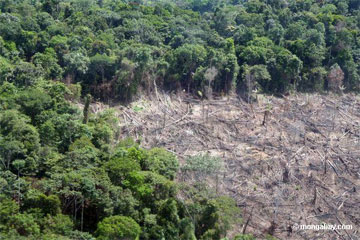Malaria linked to Amazon deforestation
Rhett A. Butler, mongabay.com
February 2, 2006
A pair studies in the Amazon rainforest suggest a link between deforestation and an increased risk of malaria.
The first study, conducted in the Peruvian Amazon and published in January’s issue of the American Journal of Tropical Medicine and Hygiene, found that malaria epidemics in the region were correlated with deforestation. The later research, released in last week’s Proceedings of the National Academy of Sciences indicates that forest clearing around settlements in the Brazilian Amazon increases the short-term risk of malaria by creating areas of standing water in which mosquitoes can lay their eggs.
Malaria is just one of a number of diseases that have been recently linked to ecosystem modification, while late last year the World Health Organization said that the rise of deadly new diseases such as SARS, Nipah virus and bird flu could be linked to the degradation and destruction of the environment. These studies cumulatively suggest that forest maintenance has important implications for health management in the Amazon and other tropical forest regions.
More than 200,000 square miles of Amazon rainforest has disappeared since 1980. The area of forest degraded by logging and fires is even greater.
A news release from the University of Wisconsin-Madison announcing the research in Peru appears below.
As Amazon’s tree line recedes, malaria-wielding mosquitoes buzz in
University of Wisconsin-Madison release
Scientists have long known that chronic deforestation can spawn a jungle of environmental woes. But now, a study confirms that vanishing forests inflict more than environmental damage: they may cause human diseases, too.
Working in the Peruvian Amazon, a team of researchers from the University of Wisconsin-Madison and Johns Hopkins University found that malaria-inducing mosquitoes are likely to bite humans more than 200 times more often in cleared areas versus forested ones. Their results appear this week in the American Journal of Tropical Medicine and Hygiene (Jan. 6, 2006).
 Deforestation in Peru |
“By dramatically changing the landscape, we are tipping the balance in a way that is increasing the risk of malaria transmission,” says senior author Jonathan Patz, a former Johns Hopkins scientist and now a professor both in UW-Madison’s Nelson Institute for Environmental Studies and the department of population health. “This is one of the most detailed quantitative field studies in the Amazon that directly addresses the potential link between deforestation and malaria.”
Over one year, the research team collected mosquitoes at 56 sites in varying stages of deforestation. The sites were located around 14 villages situated along a new road that cuts through the Amazonian rainforest, and connects the towns of Iquitos and Nauta in northeastern Peru. Working in the evenings when mosquitoes are at their thirstiest, the scientists counted how often the insects landed on humans at every site, each of which had been assigned to one of four vegetation categories, including rainforest, shrubby regrowth, cultivated areas and populated villages.
“In our study area, deforestation is followed by [agricultural] cultivation, with shrubs taking over once the land has been abandoned,” says lead author Amy Yomiko Vittor, who conducted the study while at Johns Hopkins. “Both of these altered habitats are associated with a substantial increase in the (mosquito) biting rate.”
Vittor and Patz say their work may help in efforts to better predict and manage malaria epidemics, one of the world’s most pressing public health concerns.
Malaria rates in the Peruvian Amazon have soared dramatically in recent years, jumping from a few hundred cases in 1992 to more than 120,000 cases, or over a third of the population, by 1997, says Vittor, now a fourth-year medical student at Stanford University.
With its taste for human blood, the mosquito species Anopheles darlingi is responsible for most malaria cases that occur in the Amazon basin. As trees have been steadily cleared away, the insect has presumably thrived in the more exposed, breeding-friendly pools still remaining in such disturbed habitats, says Vittor. Mosquito populations have also soared as more humans settle in the increasingly developed region.
But growing human populations are not the only explanation for the spike in Anopheles numbers, Patz says. “Most people think malaria is on the rise because the [Anopheles darlingi] feeds on the increasing numbers of humans in the rainforest. But our results show that altering the landscape plays an even larger role than simply people moving into the jungle.”
To control for the effects of human numbers on mosquito populations, the scientists compared biting rates in uninhabited, deforested areas with those in unpopulated forested sites. But even after adjusting for human populations, the scientists found that mosquitoes are still likely to attack more often in areas cleared of trees. “Having humans present did show an increase in [biting] risk, but the number of people did not explain the increase,” says Patz.
In coming months, the researchers plan to release two follow-up papers that probe other aspects of the malaria-deforestation connection in the Amazon. One examines how the location of mosquito larvae relates to deforestation and other physical and biological factors such as the presence of larval food sources. The other is an epidemiological look at malaria rates among humans living around the study area.
The fact that deforestation, one of the fastest global drivers of landscape change, may affect the prevalence of a disease like malaria raises larger issues, says Patz. “I feel conservation policy is one and the same with public health policy,” he says. “It’s probable that protected conservation areas may ultimately be an important tool in our disease prevention strategies.”
This brief contains a modified news release from the University of Wisconsin-Madison.